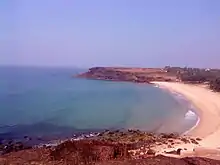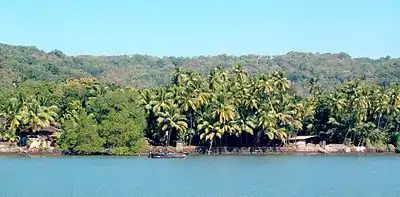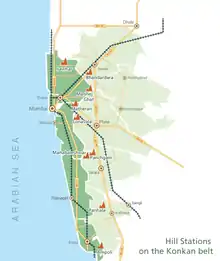Konkan
Konkan, also known as the Konkan Coast, is a rugged section of the western coastline of India. Konkan proceeds from the north at Damaon in the Gulf of Cambay, extends southwards all along the western seaside land areas of Maharashtra and Goa, and meets the Canara coast at the northern edge of Karwar district of Karnataka.

Definition
Geographically, the stretch of land from the Daman Ganga River in the north to the Gangavalli River in the south is considered to form the Konkan.[1]
The ancient Sapta Konkan was a larger geographical area that extended from Gujarat to Kerala.[2] The whole region of coastal Maharashtra and coastal Karnataka is included within the Konkan.
However, this segment overlaps the Konkan and Malabar coast continuum; and usually corresponds to the southernmost and northernmost stretches of these locales respectively.
Etymology

According to the Sahyadrikhanda of the Skanda Purana, Parashurama threw his axe into the sea and commanded the Sea God to recede up to the point where his axe landed. The new piece of land thus recovered came to be known as Saptah-Konkana, meaning "piece of earth", "corner of earth", or "piece of corner", derived from Sanskrit words: koṇa (कोण, corner) + kaṇa (कण, piece).[3][4] Xuanzang, the noted Chinese Buddhist monk, mentioned this region in his book as Konkana Desha; Varahamihira's Brihat-Samhita described Konkan as a region of India; and 15th century author Ratnakosh mentioned the word Konkandesha.[5]
Geography
Konkan extends throughout the western coasts of Maharashtra, Goa and Karnataka.[5] It is bounded by the Western Ghats mountain range (also known as Sahyadri) in the east, the Arabian Sea in the west, the Daman Ganga River in the north and the River Aghanashini in the south.
The Gangavalli flows in the district of Uttara Kannada in present-day Karnataka. Its northern bank constitutes the southernmost portion of Konkan. The towns of Karwar, Ankola, Kumta, Honavar and Bhatkal fall within the Konkan coast.

The largest city on the Konkan coast is Mumbai, the state capital of Maharashtra. These are, from north to south:[6]
Ethnology
The main ethnolinguistic group of the Konkan region is the Konkani people. Specific caste and communities found in the region are the Aagri, Kunbi, Koli, Maratha, Bhandari, Mangela, Kharvi, Karadi, Vaiti, Mahar, Chambhar, Kumbhar, Dhobi, Teli, Sutar, Gabit, Padti, Dhangar, Gaud Saraswat Brahmin (also includes Rajapur Saraswats and Chitrapur Saraswats), Daivadnya Brahmin, Kudaldeshkar, Gomantak Maratha Samaj, Chitpawan, Karhade, Daivajna, Kayastha Prabhu, Somvanshi Kshatriya Pathare, Vadval, Pathare Prabhu, Vaishya Vani, Komarpant, Gawali, Ghorpi, Nath Jogi, Gurav, Ghadi, Namdev Shimpi and others. Billava, Bunt (community) and Linghayat communities found in the parts of Karnataka which are near to Konkan.
Tribal communities include the Katkari, Thakar, Konkana, Warli, Mahadev Koli are mainly found in northern and central parts of Konkan. Dubla and Dhodia tribes in southern Gujarat, Dadra and Nagar Haveli, and Maharashtra's Palghar district. The Palghar district has the largest percentage of tribal population in Konkan. A small nomadic tribe called Vanarmare is found in southern parts of Konkan, which was originally associated with hunting of monkeys. The Gauda and Velip tribes found in Goa.
Minorities of Muslim communities like Konkani Muslims and Nawayaths are scattered throughout the region. The Jew community called Bene Israel is mainly found in Raigad district. The Christians formed of East Indians in North Konkan and Mumbai, Goan Catholics in Goa, Karwari Catholics in Uttara Kannada as well as Mangalorean Catholics in Udupi and Dakshina Kannada. Mainy Muslims, Christians and Jews have migrated to Mumbai as it is the economic hub.
See also
References
- Bhandare, Vasant Ramchandra (1985) Maharashtra-Karnataka border dispute: politics of manipulation. Kirti Prakashan. p. 63.
- Saradesāya, Manohararāya (2000) "The Land, the People, and the Language". A History of Konkani Literature: From 1500 to 1992. Sahitya Akademi. pp. 1–14. ISBN 9788172016647.
- Shastri Gaytonde, Gajanan (ed.). Shree Scanda Puran (Sayadri Khandha) (in Marathi). Mumbai: Shree Katyani Publication.
- Satoskar, B. D. Gomantak Prakruti ani Sanskruti. Part 1 (in Marathi). Shubhada Publication. p. 206.
- Saradesāya, Manohararāya (2000). "The Land, the People and the Language". A History of Konkani Literature: From 1500 to 1992. Sahitya Akademi. pp. 1–14. ISBN 8172016646.
- List of districts in Konkan division, http://www.swapp.co.in/site/indianstatedistrictlist.php?stateid=j1YKCtUvHkShwKBqk6iHow%3D%3D&divisionid=bRbHGKvCu7LMDJJGUsYuQA%3D%3D
External links
 Konkan travel guide from Wikivoyage
Konkan travel guide from Wikivoyage- Konkan Tourism - A Complete Guide on Tourism
- Konkan Hotels